Key Takeaways:
- The 50X long working distance microscope objective lens offers high magnification for clear visualization in biomedical and precision testing applications.
- Its infinite conjugate design ensures compatibility with various microscopy systems. Specifically engineered for the near ultraviolet (NUV) band, it corrects for the 355nm wavelength, achieving 50% transmittance and excellent achromatic correction.
- With a numerical aperture (NA) of 0.65 and a 10mm working distance, it excels in industrial processing. The lens maintains superior performance across the field of view, meeting flat field requirements.
50X Long Working Distance Microscope Objective Lens
Introduction
This 50X infinite conjugated long working distance microscope objective is a widely used lens applicable in various fields such as biomedical, precision testing, sample observation, and more. Its high magnification capability allows for clear visualization and high-resolution observation of extremely small-sized cells, their biological structures, and the internal structures of precision materials.
Designed to meet diverse needs, this objective lens provides precise and detailed observation capabilities across different domains. The infinite conjugate design enhances flexibility, enabling compatibility with various microscopy systems and accessories to meet different experimental and observational requirements. This powerful and versatile tool serves professionals in fields such as biology research, medical diagnostics, and materials science, and contributes to advancements in scientific research and technological development.
Specification:
Focal Length | 4mm |
Numerical Aperture (NA) | 0.65 |
Wavelength | 355-532nm |
FOV | Φ0.48mm |
Working Distance | 10mm |

Design Structure
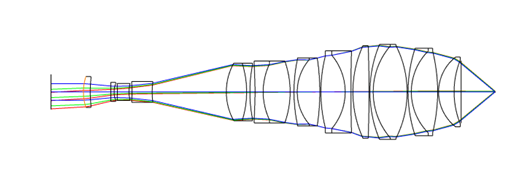
This 50X microscope objective is specifically designed to correct the NUV (Near Ultraviolet) or 355nm band, catering to the needs of near-ultraviolet lasers. With an NA of 0.65, it manages to attain an extended working distance of 10mm, providing greater flexibility for applications in industrial processing. Achieving a long working distance typically involves utilizing the front set of lenses to widen the light angle, followed by light convergence through the back set of lenses. Micro objectives with high NA and long working distances often require the use of specialized glass, resulting in a more intricate structure compared to conventional microscope objectives
Spot Diagram and MTF Measurement
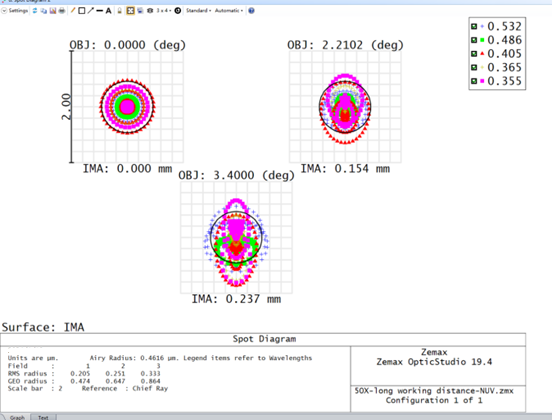
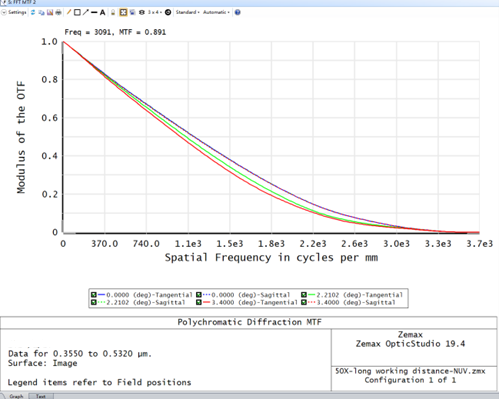
The precise evaluation of microscopic objective performance depends on the accurate measurement of the dispersion spot radius. In this model, the RMS radius of the dispersion spot is designed to be 0.205μm (on the axis), 0.251μm (at 0.7 field of view), and 0.333μm (at 1 field of view). The MTF on the axis meets 2000lp/mm, achieving the diffraction limit. Although a slight reduction in MTF occurs off the axis due to minimal astigmatism and chromatic aberration, it still meets 1500 lp/mm, approaching the diffraction limit. When used with a single-point light source, the entire field of view can meet the diffraction limit.
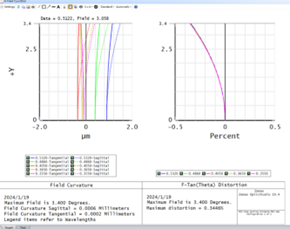
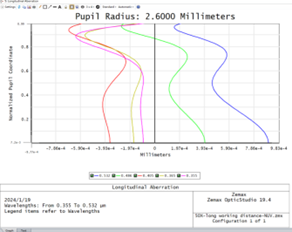
A noteworthy feature of this lens is its coverage of the 355nm wavelength in the NUV band. Calibrating in the NUV band poses challenges due to limited material options. Despite the complexity and cost involved, this design addresses the 355nm wavelength, achieving 50% transmittance and excellent achromatic correction.
This lens is compatible with eyepieces that feature a 24mm field number and a 0.48mm object field of view. Additionally, the field curvature is within the depth of focus, ensuring consistent clarity across the entire field of view and meeting the flat field requirements for microscopic objectives.
Conclusion
This 50X microscope objective is meticulously engineered to deliver superior performance with its elevated numerical aperture (NA) and expansive field of view, which is complemented by an extended working distance of 10mm—equivalent to 2.5 times the focal length. Designed to operate within the wavelength range of 355-532nm, it spans the near-ultraviolet band, making it exceptionally well-suited for precision laser processing at 355nm and 532nm. Remarkably, it also demonstrates impressive imaging capabilities at 365nm and 405nm. As a quintessential example of a high-end specialized objective, this lens stands out for its unique features, catering to specific and demanding applications.
GREAT ARTICLE!
Share this article to gain insights from your connections!

